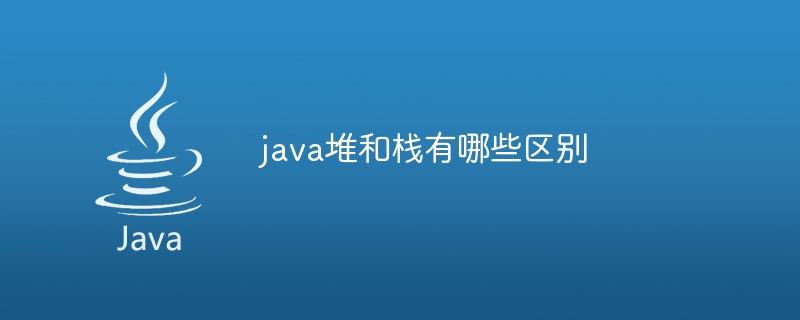
The difference between Java heap and stack: 1. Memory allocation and management; 2. Storage content; 3. Thread execution and life cycle; 4. Performance impact. Detailed introduction: 1. Memory allocation and management. The Java heap is a dynamically allocated memory area, mainly used to store object instances. In Java, objects are allocated through heap memory. When an object is created, the Java virtual machine Allocate corresponding memory space on the system, and automatically perform garbage collection and memory management. The size of the heap can be dynamically adjusted at runtime, configured through JVM parameters, etc.

The operating system for this tutorial: Windows 10 system, DELL G3 computer.
Java heap and stack are two important concepts in the Java Virtual Machine (JVM). They have obvious differences in memory management, storage objects and execution threads.
1. Memory allocation and management
The Java heap is a dynamically allocated memory area, mainly used to store object instances. In Java, objects are allocated through heap memory. When an object is created, the Java virtual machine allocates the corresponding memory space on the heap and automatically performs garbage collection and memory management. The size of the heap can be dynamically adjusted at runtime and configured through JVM parameters.
In contrast, the Java stack is thread-private, and each thread creates a stack when it is created. The stack consists of a series of stack frames, each stack frame corresponds to a method call. The stack is mainly used to store local variables of basic data types, object references and methods. The process from the beginning of the call to the end of execution of each method corresponds to the process of pushing a stack frame into the stack memory and popping it out of the stack.
2. Storage content
The Java heap is mainly used to store object instances. It is a memory area shared by all threads. Any type of object can be stored in the heap, including arrays and class instances. The objects in the heap can be any Java objects, such as String, Integer, etc. The heap is automatically managed by the garbage collector. When an object is no longer referenced, the garbage collector will automatically reclaim the heap memory occupied by the object.
The Java stack mainly stores local variables of basic data types, object references and methods. The process from the beginning of the call to the end of execution of each method corresponds to the process of pushing a stack frame into the stack memory and popping it out of the stack. The process from the call to the completion of execution of each method corresponds to the process from pushing a stack frame into the virtual machine stack to popping it out. The stack frame is a data structure used to support the virtual machine in method execution. It is also a memory area in the data area of the virtual machine when it is running.
3. Thread execution and life cycle
The Java heap is a memory area shared by all threads, while the Java stack is private to the thread. Each thread creates its own stack when it is created, and the life cycle of this stack is the same as the thread. When a thread starts, its stack is created; when the thread ends, its stack is destroyed. The execution of each method is accompanied by the pushing and popping process of a stack frame. The execution process of the method corresponds to the life cycle of its stack frame in the stack memory.
In contrast, the life cycle of the heap is the same as the start and end of the application. When the application starts, the heap is created; when the application ends, the heap is destroyed. The garbage collector automatically manages the reclamation and release of heap memory.
4. Performance impact
Since the Java heap is a memory area shared by all threads, operations on the heap are shared. This means that multiple threads can access the data in the heap at the same time and perform read and write operations. This sharing allows the heap to improve the performance of multi-threaded programs in certain situations.
In contrast, the Java stack is thread-private, and each thread has its own independent stack. Therefore, operations on the stack are thread-exclusive. This means that only one thread can access the data in a stack frame at a time, which helps avoid problems caused by concurrent access by multiple threads. However, since each thread has its own independent stack, it may take up more memory space.
To sum up, there are obvious differences between Java heap and stack in terms of memory allocation and management, storage content, thread execution and life cycle, and performance impact. Understanding these differences can help you better understand the memory model and working principles of the Java virtual machine, and how to optimize your program's performance and memory usage.
The above is the detailed content of What are the differences between java heap and stack. For more information, please follow other related articles on the PHP Chinese website!
